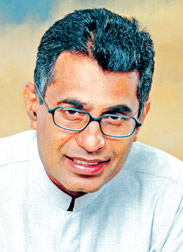|
No longer in the ‘red’:
Brighter times ahead for CEB
by Shirajiv Sirimane
 Minister
of Power and Energy Patali Champika Ranawaka has achieved an impossible
goal and has turned around one of the biggest loss-making institutions
in the country and one of the biggest financial burdens on the Treasury,
the Ceylon Electricity Board (CEB), into a profit-making institution. Minister
of Power and Energy Patali Champika Ranawaka has achieved an impossible
goal and has turned around one of the biggest loss-making institutions
in the country and one of the biggest financial burdens on the Treasury,
the Ceylon Electricity Board (CEB), into a profit-making institution.
Last year, when the decision-makers of the CEB met to discuss the
2010 financial year, they budgeted for a Rs. 40 billion loss.
However, due to strict financial discipline, cost cutting, minimising
the dependency on thermal energy, change of attitudes and positive
thinking backed by the close supervision of the Minister, the Ceylon
Electricity Board, which had been written off as a loss-making
institution, has now been converted to a profit-making body. The profit
for last year was over Rs. 15 billion.
The Minister told the Sunday Observer that one of the main reasons
for the CEB to be in the ‘red’ was lack of a vision for the future,
dependence on thermal power (the expensive mode of generating power
through diesel energy) and high overheads. In addition the CEB had an
operational loss, cash deficit, short-term debt and other major
financial obligations.
He said the reason they had to bank on thermal energy was because no
power generation projects had commenced since 1990. “We purchase a unit
of thermal energy for around Rs. 19 and sell it back to the consumer at
Rs. 13. The loss incurred was Rs. 6 billion!”, he said.
“We must thank President Mahinda Rajapaksa for taking a bold
initiative to launch both Upper Kotmale and Norochcholai power projects
which had been confined to ‘discussions’ for the past 20 years,” he
said.
The Minister said they were able to save Rs. 4 million by managing
human resources and savings from purchases.
He said that the CEB also has many social obligations to fulfil. “If
you take a house in a rural village, we have to give them electricity
and
sometimes we have to spend nearly Rs. 200,000 on the connection. But
we charge only Rs. 12,000 from them and their monthly bill would also be
less than Rs. 600!”
He said that similarly, electrifying the North and the East too is an
expensive affair, but said they would go ahead with the project as they
want to electrify the whole country by 2012.
The CEB will invest Rs. 50 million to electrify a 24-kilometre
stretch from Mankulam to Pooneryn.
The work on this project would commence in May and it would benefit
over 1,000 families in the area. This is the first time in history that
some of these areas would gain access to electricity.
He also said that the main underground cable in the Colombo City was
over 60 years old and needs to be replaced. “We received aid to lay new
cables. However, we have to invest more.”
Minister Ranawaka said they spend Rs. 279 million annually for street
lights which remains a gray area. In addition they have to receive over
Rs. 12 billion from certain government institutions such as hospitals.
The bill we shoulder for providing electricity to religious places is Rs.
160 million.”
He said with all these negative factors, the CEB, in addition to
boasting an operation profit, has also reported a ‘total’ profit. The
overdrafts have been brought down to zero and the Ministry is now in a
position to raise its head as an institution without being a burden on
the government.
“Today, the CEB employees can hold their heads high in society as
they are no longer a burden to the taxpayer,” he said.
The Minister, who himself is an electrical engineer, said that the
CEB had made two glaring mistakes in the recent past which attributed to
the huge losses. “One was to only bank on Hydro Power. When there was a
severe drought in 1996 there were power cuts.”
He said when the country was dependent on thermal power, oil prices
shot to record highs in 2008, resulting in high overheads to the CEB.
“We then decided not to bank on a single energy source. Now we have
300MW of coal power coming from Norochcholai and soon will have solar
power from Hambantota and an additional 150 MW from Upper Kotmale.
The Broadland power project in Avissawella would add a further 35 MW
of hydro power to the national grid next year.”
He said they are also looking at other forms of energy in nuclear,
garbage, wind and even energy from the sea.
He said that with these measures in place, the CEB would never be in
the ‘red’ again. The Minister said that he does not agree with the
belief that Sri Lanka has the highest electricity tariffs.
“It’s true that Korea and some other countries have lower tariffs.
However, they do not subsidise on other aspects such as health and
fertiliser and provide other handouts.”
Ranawaka said that Sri Lanka can also boast of maintaining an
uninterrupted power supply and providing the correct voltage and
frequency as other countries in the region.
This is the reason both India and Bangladesh are making advances to
Sri Lanka to ‘export’ electricity to their countries. |

